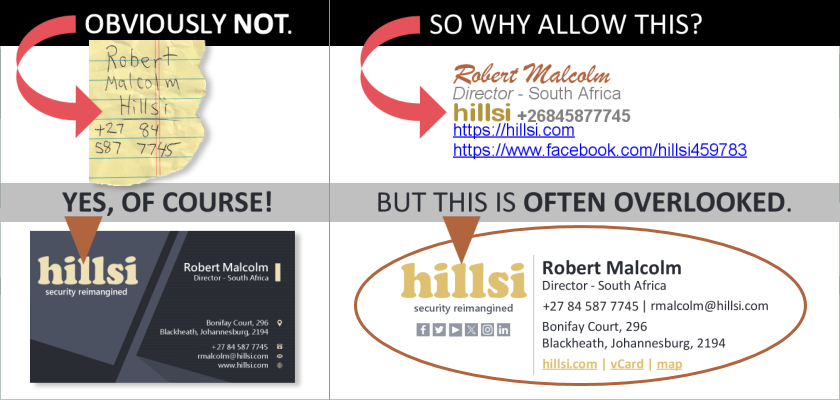Article Originally Published in Digital Agency Network.
Introduction
Email signatures often serve as the digital equivalent of printed business cards – a brand-forward means of sharing contact information. As such, they should be taken seriously.

Employees are never asked to create their own business cards, so they should never be left to create their own email signatures (and when they are, “create” is often the operative word – involving bright colors, script fonts, poorly inserted images and catchy motivational phrases).
Here’s what should be expected out of a properly executed email signature program:
- A professional first impression created by the visual appearance of the emails emanating from your client’s organization.
- Email messages adhering to brand-standards across all employees.
- Efficiencies when composing email in not having to spell out contact information each time.
- Efficiencies for email recipients in terms of calling the sender, visiting their website, or navigating to their physical location.
- Compliance with any legally mandated or recommended disclaimers.
- Inclusion of any legally mandated employee-specific license numbers.
- A method of widely sharing links to your social media.
- A platform for making time-sensitive announcements (trade show appearances, holiday hours, new products or services, etc.).
More importantly than these individual benefits, is the cumulative effect that begins immediately upon launch of a well-crafted professional email signature program. If your client launches their program at noon, the benefits begin accruing at 12:01 pm and never stop!
You work hard at establishing your client’s brands – don’t let them adversely affect your efforts when sending routine email messages. A bad email signature isn’t brand-neutral, it's brand-negative!
The In-House Approach, and its Drawbacks
As a branding agency, it’s likely that you’re already providing your client with web development and graphic design services. You may, therefore, consider taking on their email signature project as well. However, there are a few drawbacks:
- Finicky: Many things that are taken for granted in HTML programming simply don’t work when it comes to email signatures. Or worse yet, they don’t work well - they work just enough for you to believe that you’re providing a quality deliverable, but once it’s put into day-to-day use, problems can quickly surface.
- Effort to Create at Scale: How do you go from one coded signature to 100, or 1000? Especially when individual users have nuanced requirements.
- Deployment at Scale: Once you’ve got your 100, or 1000 signatures created, how do you get them installed in user’s email programs, so that they are functioning as desired? Some users will have Outlook desktop (Windows or Mac), some use Outlook Web, some the Outlook mobile app. What’s the plan for getting the signature correctly installed for each user on each device?
- Require Continuing Support: Email is used on a massive scale. No matter what, there will be some failures / anomalies with the email signatures. While many users are oblivious, some will reach out for answers / solutions. Are you prepared to provide this level of service?
- Ongoing Maintenance Expectations: Email signatures aren’t just static. There’s a "25 year" anniversary logo. Twitter becomes X. An office relocates, requiring an address change. The client wants to publicize a webinar or scheduled appearance at a trade show. Each change requires recreating the HTML code for every user and then redeploying the updated code to every user (on each device).
In conclusion, if your client is small and has cooperative support from their IT team, an in-house approach may be reasonable. Conversely, if they’re larger (50+ users) and/or have limited IT support available, you may find that by taking on this project you’ve bitten off more than you want to chew.
Outsource Approach #1 – Third-Party Email Signature Software
Off-the-shelf email signature software is widely available and overcomes most of the drawbacks mentioned above. The market for this type of software is mature, so you have many options to choose from.

